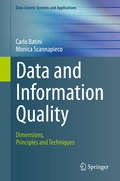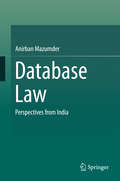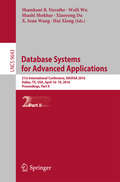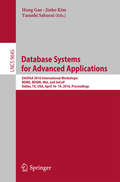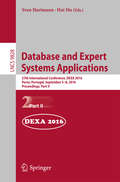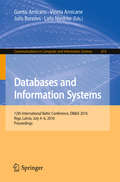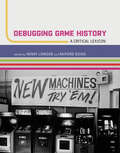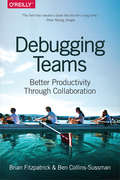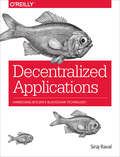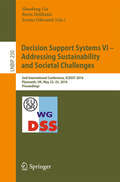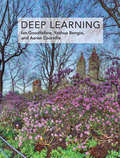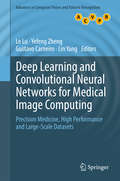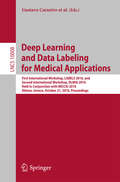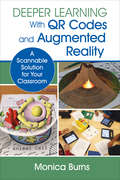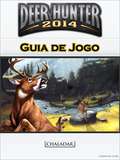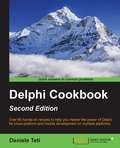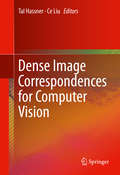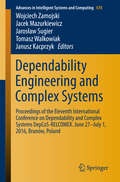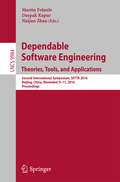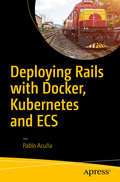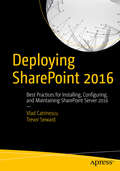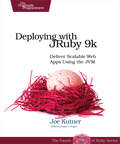- Table View
- List View
Data and Information Quality: Dimensions, Principles and Techniques (Data-Centric Systems and Applications #0)
by Carlo Batini Monica ScannapiecoThis book provides a systematic and comparative description of the vast number of research issues related to the quality of data and information. It does so by delivering a sound, integrated and comprehensive overview of the state of the art and future development of data and information quality in databases and information systems. To this end, it presents an extensive description of the techniques that constitute the core of data and information quality research, including record linkage (also called object identification), data integration, error localization and correction, and examines the related techniques in a comprehensive and original methodological framework. Quality dimension definitions and adopted models are also analyzed in detail, and differences between the proposed solutions are highlighted and discussed. Furthermore, while systematically describing data and information quality as an autonomous research area, paradigms and influences deriving from other areas, such as probability theory, statistical data analysis, data mining, knowledge representation, and machine learning are also included. Last not least, the book also highlights very practical solutions, such as methodologies, benchmarks for the most effective techniques, case studies, and examples. The book has been written primarily for researchers in the fields of databases and information management or in natural sciences who are interested in investigating properties of data and information that have an impact on the quality of experiments, processes and on real life. The material presented is also sufficiently self-contained for masters or PhD-level courses, and it covers all the fundamentals and topics without the need for other textbooks. Data and information system administrators and practitioners, who deal with systems exposed to data-quality issues and as a result need a systematization of the field and practical methods in the area, will also benefit from the combination of concrete practical approaches with sound theoretical formalisms.
Database Law: Perspectives from India
by Anirban MazumderThis book focuses on database law (a branch of intellectual property law) and further explores the legal protection currently available for data and data-related products in India. It offers a comparative study of the position of copyright law in protecting databases in the US and EU, while also presenting responses from the Indian database industry and its aspirations regarding the role of copyright law in database protection. India is undoubtedly leading the way as a knowledge economy. Its strengths are its information technology capability and its knowledge society, as well as its booming database industry aspects that also necessitate the study of the role of law, as well as the protection of data and databases, in India. This book examines the growing importance of copyright law for protecting databases as well as for ensuring access in information societies. The book concludes with a discussion of key principles to be kept in mind in the context of drafting legal regimes for databases in India that will both benefit the database industry and ensure accessibility. "
Database Systems for Advanced Applications: 21st International Conference, DASFAA 2016, Dallas, TX, USA, April 16-19, 2016, Proceedings, Part II (Lecture Notes in Computer Science #9643)
by Shashi Shekhar Hui Xiong X. Sean Wang Shamkant B. Navathe Weili Wu Xiaoyong DuThis two volume set LNCS 9642 and LNCS 9643 constitutesthe refereed proceedings of the 21st International Conference on DatabaseSystems for Advanced Applications, DASFAA 2016, held in Dallas, TX, USA, inApril 2016. The 61 full papers presented were carefully reviewed andselected from a total of 183 submissions. The papers cover the followingtopics: crowdsourcing, data quality, entity identification, data mining andmachine learning, recommendation, semantics computing and knowledge base,textual data, social networks, complex queries, similarity computing, graphdatabases, and miscellaneous, advanced applications.
Database Systems for Advanced Applications: DASFAA 2016 International Workshops: BDMS, BDQM, MoI, and SeCoP, Dallas, TX, USA, April 16-19, 2016, Proceedings (Lecture Notes in Computer Science #9645)
by Jinho Kim Hong Gao Yasushi SakuraiThis book constitutes the workshop proceedings of the 21st International Conference on Database Systems for Advanced Applications, DASFAA 2016, held in Dallas, TX, USA, in April 2016. The volume contains 32 full papers (selected from 43 submissions) from 4 workshops, each focusing on a specific area that contributes to the main themes of DASFAA 2016: The Third International Workshop on Semantic Computing and Personalization, SeCoP 2016; the Third International Workshop on Big Data Management and Service, BDMS 2016; the First International Workshop on Big Data Quality Management, BDQM 2016; and the Second International Workshop on Mobile of Internet, MoI 2016.
Database and Expert Systems Applications: 27th International Conference, DEXA 2016, Porto, Portugal, September 5-8, 2016, Proceedings, Part II (Lecture Notes in Computer Science #9828)
by Sven Hartmann Hui MaThis two volume set LNCS 9827 and LNCS 9828 constitutes the refereed proceedings of the 27th International Conference on Database and Expert Systems Applications, DEXA 2016, held in Porto, Portugal, September 2016. The 39 revised full papers presented together with 29 short papers were carefully reviewed and selected from 137 submissions. The papers discuss a range of topics including: Temporal, Spatial, and High Dimensional Databases; Data Mining; Authenticity, Privacy, Security, and Trust; Data Clustering; Distributed and Big Data Processing; Decision Support Systems, and Learning; Data Streams; Data Integration, and Interoperability; Semantic Web, and Data Semantics; Social Networks, and Network Analysis; Linked Data; Data Analysis; NoSQL, NewSQL; Multimedia Data; Personal Information Management; Semantic Web and Ontologies; Database and Information System Architectures; Query Answering and Optimization; Information Retrieval, and Keyword Search; Data Modelling, and Uncertainty.
Databases and Information Systems: 12th International Baltic Conference, DB&IS 2016, Riga, Latvia, July 4-6, 2016, Proceedings (Communications in Computer and Information Science #615)
by Guntis Arnicans Vineta Arnicane Juris Borzovs Laila NiedriteThis book constitutes the refereed proceedings of the 12th International Baltic Conference on Databases and Information Systems, DB&IS 2016, held in Riga, Latvia, in July 2016. The 25 revised full papers presented were carefully reviewed and selected from 62 submissions. The papers are organized in topical sections on ontology, conceptual modeling and databases; tools, technologies and languages for model-driven development; decision support systems and data mining; advanced systems and technologies; business process modeling and performance measurement; software testing and quality assurance; linguistic components of IS; information technology in teaching and learning.
Debugging Game History: A Critical Lexicon (Game Histories)
by Raiford Guins Henry LowoodEssays discuss the terminology, etymology, and history of key terms, offering a foundation for critical historical studies of games.Even as the field of game studies has flourished, critical historical studies of games have lagged behind other areas of research. Histories have generally been fact-by-fact chronicles; fundamental terms of game design and development, technology, and play have rarely been examined in the context of their historical, etymological, and conceptual underpinnings. This volume attempts to “debug” the flawed historiography of video games. It offers original essays on key concepts in game studies, arranged as in a lexicon—from “Amusement Arcade” to “Embodiment” and “Game Art” to “Simulation” and “World Building.” Written by scholars and practitioners from a variety of disciplines, including game development, curatorship, media archaeology, cultural studies, and technology studies, the essays offer a series of distinctive critical “takes” on historical topics. The majority of essays look at game history from the outside in; some take deep dives into the histories of play and simulation to provide context for the development of electronic and digital games; others take on such technological components of games as code and audio. Not all essays are history or historical etymology—there is an analysis of game design, and a discussion of intellectual property—but they nonetheless raise questions for historians to consider. Taken together, the essays offer a foundation for the emerging study of game history. ContributorsMarcelo Aranda, Brooke Belisle, Caetlin Benson-Allott, Stephanie Boluk, Jennifer deWinter, J. P. Dyson, Kate Edwards, Mary Flanagan, Jacob Gaboury, William Gibbons, Raiford Guins, Erkki Huhtamo, Don Ihde, Jon Ippolito, Katherine Isbister, Mikael Jakobsson, Steven E. Jones, Jesper Juul, Eric Kaltman, Matthew G. Kirschenbaum, Carly A. Kocurek, Peter Krapp, Patrick LeMieux, Henry Lowood, Esther MacCallum-Stewart, Ken S. McAllister, Nick Monfort, David Myers, James Newman, Jenna Ng, Michael Nitsche, Laine Nooney, Hector Postigo, Jas Purewal, Reneé H. Reynolds, Judd Ethan Ruggill, Marie-Laure Ryan, Katie Salen Tekinbaş, Anastasia Salter, Mark Sample, Bobby Schweizer, John Sharp, Miguel Sicart, Rebecca Elisabeth Skinner, Melanie Swalwell, David Thomas, Samuel Tobin, Emma Witkowski, Mark J.P. Wolf
Debugging Teams: Better Productivity through Collaboration
by Ben Collins-Sussman Brian W. FitzpatrickIn the course of their 20+-year engineering careers, authors Brian Fitzpatrick and Ben Collins-Sussman have picked up a treasure trove of wisdom and anecdotes about how successful teams work together. Their conclusion? Even among people who have spent decades learning the technical side of their jobs, most haven’t really focused on the human component. Learning to collaborate is just as important to success. If you invest in the "soft skills" of your job, you can have a much greater impact for the same amount of effort. The authors share their insights on how to lead a team effectively, navigate an organization, and build a healthy relationship with the users of your software. This is valuable information from two respected software engineers whose popular series of talks—including "Working with Poisonous People"—has attracted hundreds of thousands of followers.
Decentralized Applications: Harnessing Bitcoin's Blockchain Technology
by Siraj RavalTake advantage of Bitcoin’s underlying technology, the blockchain, to build massively scalable, decentralized applications known as dapps. In this practical guide, author Siraj Raval explains why dapps will become more widely used—and profitable—than today’s most popular web apps. You’ll learn how the blockchain’s cryptographically stored ledger, scarce-asset model, and peer-to-peer (P2P) technology provide a more flexible, better-incentivized structure than current software models.Once you understand the theory behind dapps and what a thriving dapp ecosystem looks like, Raval shows you how to use existing tools to create a working dapp. You’ll then take a deep dive into the OpenBazaar decentralized market, and examine two case studies of successful dapps currently in use.Learn advances in distributed-system technology that make distributed data, wealth, identity, computing, and bandwidth possibleBuild a Twitter clone with the Go language, distributed architecture, decentralized messaging app, and peer-to-peer data storeLearn about OpenBazaar’s decentralized market and its structure for supporting transactionsExplore Lighthouse, a decentralized crowdfunding project that rivals sites such as Kickstarter and IndieGogoTake an in-depth look at La’Zooz, a P2P ridesharing app that transmits data directly between riders and drivers
Decision Support Systems VI - Addressing Sustainability and Societal Challenges
by Boris Delibašić Shaofeng Liu Festus OderantiThisbook constitutes the refereed proceedings of the Second InternationalConference on Decision Support Systems Technology, ICDSST 2016, held inPlymouth, UK, May 23-25. The theme of the event was "Decision SupportSystems Addressing Sustainability &Societal Challenges", organized by the EURO (Association of EuropeanOperational Research Societies) working group of Decision Support Systems(EWG-DSS). The 15 full papers presented inthis book were selected out of 51 submissions after being carefully reviewed byinternationally experts from the ICDSST 2016 Program Committee and externalinvited reviewers. The selected papers are representative of current andrelevant research activities in various areas of decision supportsystems, such as sustainability and societal challenges; risk management and project portfoliomanagement; business intelligence and knowledge management; and technologies toimprove system usability.
Deep Learning (Adaptive Computation and Machine Learning series)
by Ian Goodfellow Yoshua Bengio Aaron CourvilleAn introduction to a broad range of topics in deep learning, covering mathematical and conceptual background, deep learning techniques used in industry, and research perspectives.“Written by three experts in the field, Deep Learning is the only comprehensive book on the subject.”—Elon Musk, cochair of OpenAI; cofounder and CEO of Tesla and SpaceXDeep learning is a form of machine learning that enables computers to learn from experience and understand the world in terms of a hierarchy of concepts. Because the computer gathers knowledge from experience, there is no need for a human computer operator to formally specify all the knowledge that the computer needs. The hierarchy of concepts allows the computer to learn complicated concepts by building them out of simpler ones; a graph of these hierarchies would be many layers deep. This book introduces a broad range of topics in deep learning. The text offers mathematical and conceptual background, covering relevant concepts in linear algebra, probability theory and information theory, numerical computation, and machine learning. It describes deep learning techniques used by practitioners in industry, including deep feedforward networks, regularization, optimization algorithms, convolutional networks, sequence modeling, and practical methodology; and it surveys such applications as natural language processing, speech recognition, computer vision, online recommendation systems, bioinformatics, and videogames. Finally, the book offers research perspectives, covering such theoretical topics as linear factor models, autoencoders, representation learning, structured probabilistic models, Monte Carlo methods, the partition function, approximate inference, and deep generative models. Deep Learning can be used by undergraduate or graduate students planning careers in either industry or research, and by software engineers who want to begin using deep learning in their products or platforms. A website offers supplementary material for both readers and instructors.
Deep Learning and Convolutional Neural Networks for Medical Image Computing
by Yefeng Zheng Gustavo Carneiro Le Lu Lin YangThis book presents a detailed review of the state of the art in deep learning approaches for semantic object detection and segmentation in medical image computing, and large-scale radiology database mining. A particular focus is placed on the application of convolutional neural networks, with the theory supported by practical examples. Features: highlights how the use of deep neural networks can address new questions and protocols, as well as improve upon existing challenges in medical image computing; discusses the insightful research experience of Dr. Ronald M. Summers; presents a comprehensive review of the latest research and literature; describes a range of different methods that make use of deep learning for object or landmark detection tasks in 2D and 3D medical imaging; examines a varied selection of techniques for semantic segmentation using deep learning principles in medical imaging; introduces a novel approach to interleaved text and image deep mining on a large-scale radiology image database.
Deep Learning and Data Labeling for Medical Applications
by Andrew Bradley Marco Loog João Manuel R. S. Tavares Jaime S. Cardoso Gustavo Carneiro Diana Mateus Loïc Peter Vasileios Belagiannis João Paulo Papa Jacinto C. Nascimento Zhi Lu Julien CornebiseThis book constitutes the refereed proceedings of two workshops held at the 19th International Conference on Medical Image Computing and Computer-Assisted Intervention, MICCAI 2016, in Athens, Greece, in October 2016: the First Workshop on Large-Scale Annotation of Biomedical Data and Expert Label Synthesis, LABELS 2016, and the Second International Workshop on Deep Learning in Medical Image Analysis, DLMIA 2016. The 28 revised regular papers presented in this book were carefully reviewed and selected from a total of 52 submissions. The 7 papers selected for LABELS deal with topics from the following fields: crowd-sourcing methods; active learning; transfer learning; semi-supervised learning; and modeling of label uncertainty. The 21 papers selected for DLMIA span a wide range of topics such as image description; medical imaging-based diagnosis; medical signal-based diagnosis; medical image reconstruction and model selection using deep learning techniques; meta-heuristic techniques for fine-tuning parameter in deep learning-based architectures; and applications based on deep learning techniques.
Deeper Learning With QR Codes and Augmented Reality: A Scannable Solution for Your Classroom (Corwin Teaching Essentials)
by Monica BurnsEngaging, interactive learning—right in your students’ hands! What if your students’ mobile devices became an instructional asset rather than a distraction? Discover how free, scannable technology can enrich learning, while captivating students. Best of all, these technologies are easy to quickly implement within your classroom. Learn about QR codes and Augmented Reality (AR) Reach each student with new, hands-on learning opportunities Embrace the ACES Framework for teaching with scannable technologies: Access, Curate, Engage, and Share Promote self-directed learning and showcase students’ creations Leverage technology to connect classroom activities with students’ families and the broader community
Deeper Learning With QR Codes and Augmented Reality: A Scannable Solution for Your Classroom (Corwin Teaching Essentials)
by Monica BurnsEngaging, interactive learning—right in your students’ hands! What if your students’ mobile devices became an instructional asset rather than a distraction? Discover how free, scannable technology can enrich learning, while captivating students. Best of all, these technologies are easy to quickly implement within your classroom. Learn about QR codes and Augmented Reality (AR) Reach each student with new, hands-on learning opportunities Embrace the ACES Framework for teaching with scannable technologies: Access, Curate, Engage, and Share Promote self-directed learning and showcase students’ creations Leverage technology to connect classroom activities with students’ families and the broader community
Deer Hunter 2014 Guia de Jogo
by Joshua Abbott Gerlon de Jesus Magalhães SantosCom o "Deer Hunter 2014 - Guia de Jogo" você vai aprender exatamente o que você precisa saber para se tornar um jogador experiente e baixar tudo de graça! Meu guia abrange os seguintes tópicos: - Visão geral e Informações Básicas. - Como jogar o jogo. - Ter energia imilitada e gratuitamente. - Visão geral das armas - Estratégias de caça. - Dicas profissionais e Estratégias. - Estratégias para todas as missões! - Segredos, dicas e truques usados pelos jogadores profissionais! - Detalhes de Instruções passo a passo! - Jogo Geral e Estratégias Geral. - Como vencer o jogo. - E muito mais! Compre agora e nunca mais fique preso em nível, tentando bate-lo! Torne-se ainda hoje um Jogador de alto nível! Aviso Legal: Este produto não está associado, afiliado, endossado ou patrocinado pela Glu Mobile Inc, nem foram revistos e testados ou certificado por Glu Mobile Inc. Este guia é para ser usado como uma referência. Isso não modificar ou alterar o jogo de qualquer maneira. Este é um guia e não escrito um programa de software. Tipo: Jogos / Videogames
Delphi Cookbook - Second Edition
by Daniele TetiOver 60 hands-on recipes to help you master the power of Delphi for cross-platform and mobile development on multiple platforms About This Book * Get to grips with Delphi to build and deploy various cross-platform applications * Design, develop, and deploy real-world applications by implementing a single source codebase * This swift guide will increase your productivity to develop applications with Delphi Who This Book Is For If you are an intermediate developer with a basic knowledge of Delphi and you want to develop cross-platform applications, then this book is for you. Familiarity with the fundamentals of RAD (Rapid Application Development) Studio is expected. What You Will Learn * Develop visually stunning applications using FireMonkey * Deploy LiveBinding effectively with the right OOP approach * Create server-side programs to serve RESTful web services and provide data to your mobile apps * Use well-defined GUI design patterns to build mobile applications that provide a great user experience * Build mobile apps that read data from a remote server efficiently * Call the platform native API on Android and iOS even for an unpublished API * Manage software customization for your customer by making better use of an extended RTTI * Implement the most popular design pattern without wasting too much time on debugging and bug fixing In Detail Delphi is a cross-platform Integrated Development Environment (IDE) that supports rapid application development for Microsoft Windows, Apple Mac OS X, Google Android, and Apple iOS. It helps you to concentrate on the real business and save yourself the pain of wandering amid GUI widget details, or having to tackle inter-platform incompatibilities. It also has a wide range of drag-and-drop controls, helping you code your business logic into your business model, and it compiles natively for desktop and mobile platforms. This book will teach you how to design and develop applications, deploy them on the cloud platform, and distribute them within an organization via Google Play and other similar platforms. You will begin with the basics of Delphi and get acquainted with JSON format strings, XSLT transformations, unicode encodings and various types of streams. We then move on to more advanced topics such as developing higher-order functions and using enumerators and RTTI. You will get an understanding of how Delphi RTL functions and how to use FireMonkey in a VCL application. We will then cover topics such as multithreading, using the parallel programming library and putting Delphi on a server. We will also take a look at the new feature of WebBroker Apache modules and then ride the mobile revolution with FireMonkey. By the end of the book, you will be able to develop and deploy cross-platform applications using Delphi. Style and approach Delphi Cookbook is an easy-to-follow guide, rich with hands-on examples of real-world programming tasks in Delphi.
Democracy’s Detectives: The Economics of Investigative Journalism
by James T. HamiltonInvestigative journalism holds democracies and individuals accountable to the public. But important stories are going untold as news outlets shy away from the expense of watchdog reporting. Computational journalism, using digital records and data-mining algorithms, promises to lower the cost and increase demand among readers, James Hamilton shows.
Democratizing Journalism through Mobile Media: The Mojo Revolution (Routledge Research in Journalism)
by Ivo BurumFuelled by a distrust of big media and the development of mobile technologies, the resulting convergence of journalism praxis (professional to alternative), workflows (analogue to multipoint digital) and platforms (PC to mobile), result in a 24-hour always-on content cycle. The information revolution is a paradigm shift in the way we develop and consume information, in particular the type we call news. While many see this cultural shift as ruinous, Burum sees it as an opportunity to utilize the converging information flow to create a galvanizing and common digital language across spheres of communication: community, education and mainstream media. Embracing the digital literacies researched in this book will create an information bridge with which to traverse journalism’s commercial precarity, the marginalization of some communities, and the journalism school curricula.
Dense Image Correspondences for Computer Vision
by Tal Hassner Ce LiuThis book describes the fundamental building-block of many new computer vision systems: dense and robust correspondence estimation. Dense correspondence estimation techniques are now successfully being used to solve a wide range of computer vision problems, very different from the traditional applications such techniques were originally developed to solve. This book introduces the techniques used for establishing correspondences between challenging image pairs, the novel features used to make these techniques robust, and the many problems dense correspondences are now being used to solve. The book provides information to anyone attempting to utilize dense correspondences in order to solve new or existing computer vision problems. The editors describe how to solve many computer vision problems by using dense correspondence estimation. Finally, it surveys resources, code and data, necessary for expediting the development of effective correspondence-based computer vision systems.
Dependability Engineering and Complex Systems
by Janusz Kacprzyk Wojciech Zamojski Jacek Mazurkiewicz Jarosław Sugier Tomasz WalkowiakThese proceedings present the results of the Eleventh International Conference on Dependability and Complex Systems DepCoS-RELCOMEX which took place in a picturesque Brunów Palace in Poland from 27th June to 1st July, 2016. DepCoS-RELCOMEX is a series of international conferences organized annually by Department of Computer Engineering of WrocÅ,aw University of Science and Technology since 2006. The roots of the series go as far back as to the seventies of the previous century - the first RELCOMEX conference took place in 1977 - and now its main aim is to promote a multi-disciplinary approach to dependability problems in theory and engineering practice of complex systems. Complex systems, nowadays most often computer-based and distributed, are built upon a variety of technical, information, software and human resources. The challenges in their design, analysis and maintenance not only originate from the involved technical and organizational structures but also from the complexity of the information processes that must be efficiently executed in a diverse, often hostile operational environment. Traditional methods of reliability evaluation focused only on technical resources are usually insufficient in this context and more innovative, multidisciplinary methods of dependability analysis must be applied. The diversity of the topics which need to be considered is well illustrated by the selection of the submissions in these proceedings with their subjects ranging from mathematical models and design methodologies through software engineering and data security issues up to practical problems in technical, e. g. transportation, systems.
Dependable Software Engineering: Theories, Tools, and Applications
by Martin Fränzle Naijun Zhan Deepak KapurThis book constitutes the refereed proceedings of the Second International Symposium on Dependable Software Engineering: Theories, Tools, and Applications, SETTA 2016, held in Beijing, China, in November 2016. The 17 full papers presented together with 3 short papers were carefully reviewed and selected from 58 submissions. The aim of the symposium is to bring together international researchers and practitioners in the field of software technology. Its focus is on formal methods and advanced software technologies, especially for engineering complex, large-scale artifacts like cyber-physical systems, networks of things, enterprise systems, or cloud-based services.
Deploying Rails with Docker, Kubernetes and ECS
by Pablo AcuñaLearn how to use the power of Docker and Kubernetes to deploy your Rails applications easily and efficiently. Deploying Rails with Docker, Kubernetes and ECS shows you how to set up the project, push it to DockerHub, manage services and set up an efficient continuous integration environment. Every concept is clearly explained alongside a full Ruby on Rails application deployment. You’ll also learn how to deploy via Docker using Amazon EC2 Container Service.Docker and Kubernetes are increasing in popularity every day, but what if you want to leverage their benefits for your Rails application? This is the quick guide you need.What You Will LearnCreate a Rails API application using Rails 5 and PostgreSQL, and Dockerize itWrite and test templates to run the application with KubernetesCreate a Kubernetes cluster in Amazon Web Services and run yourInspect and troubleshoot problems in the clusterAutomatize the the whole deployment process with JenkinsWho This Book Is ForThis book is for anyone who wants to understand how to effectively deploy a Rails application using Docker and Kubernetes. You will need to understand Rails and have basic knowledge of what Docker and Kubernetes are used for.
Deploying SharePoint 2016
by Vlad Catrinescu Trevor SewardSee how to install, configure, and maintain the latest release of Microsoft's popular SharePoint Server, SharePoint 2016. This latest version brings with it many changes for IT professionals. Read Deploying SharePoint 2016 to find out how to create a performant and stable SharePoint environment for your company. What You'll Learn: Install SharePoint Server 2016, both using the user interface provided by Microsoft, and by using PowerShell. Understand your authentication options and associated security considerations. Deploy add-ins, either from the store, or from your own custom app catalog. Configure Search Service Application using either the provided UI or PowerShell. Configure business intelligence components such as Excel Services, SQL Server Reporting Services, and PowerPivot. Migrate to SharePoint Server 2016 from either SharePoint Server 2010 or 2013. Understand approaches to high availability, disaster recovery, patching, and ways to monitor and maintain your SharePoint 2016 deployment once it's up and running. Who This Book Is For: Anyone tasked with installing, configuring, and maintaining SharePoint Server 2016 in their organization. This book assumes some working knowledge of a previous release of SharePoint Server, such as SharePoint 2010 or SharePoint 2013.
Deploying with JRuby 9k: Deliver Scalable Web Apps Using the JVM
by Joe KutnerDeploy using the JVM's high performance while building your apps in the language you love. This book introduces you to three JRuby deployment strategies that give you the performance and scalability you need, while you use a language designed for rapid development. Explore common deployment scenarios, including consolidating an MRI-based Ruby deployment onto a single JVM process and porting a Rails application to JRuby, getting it into production, and keeping it running. This new edition has new chapters on Puma, performance tuning, and Java integration, and is updated to the latest versions of JRuby 9k, Rails 4, and JDK 8.JRuby is a fast, scalable, and powerful JVM language with all the benefits of a traditional Ruby environment. JRuby deployments have fewer moving parts and consume less memory than traditional Ruby. With this book, you can now use JRuby in the real world to build high-performance, scalable applications.Deploying your apps on the JVM requires some new approaches. Start by creating a JRuby microservice that takes advantage of the JVM's native concurrency. Then use Docker to build a virtual production environment that's a stable, reproducible place to explore JRuby deployment. Next, port an existing Rails application to JRuby, preparing the app to take advantage of the JVM platform--all while keeping everything that's friendly and familiar to Ruby developers. Deploy the Rails app to Docker with a multi-threaded Puma server to Heroku or your own private cloud.Take advantage of powerful Java libraries. See how JRuby fits into the enterprise by switching your app to use TorqueBox, an all-in-one JRuby environment that includes built-in support for messaging, scheduling, and daemons--perfect for handling the big jobs. Finally, take a deep dive into JVM performance tuning and set up a continuous deployment environment with Travis CI.What You Need:To run the examples in this book, you'll need a computer that can run the Java Virtual Machine and a connection to the Internet.
